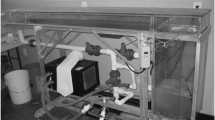Abstract
From 1987–1990, uncontaminated Asiatic clams (Corbicula fluminea) were placed in cages and transplanted into two streams receiving industrial discharges to help identify and quantify polychlorinated biphenyl (PCB) contamination to the streams. Clams accumulated substantial PCB residues at most sites monitored, with the exception of the sites closest to chlorinated discharges. Clams placed nearest to the chlorinated stream reaches consistently underestimated PCB contamination, based on the amount of PCBs found in fish and sediment at those sites. In a separate experiment, clams exposed in stream-side tanks to untreated (total residual chlorine ranged from 0.02–0.07 mg−1 L daily) and dechlorinated stream water exhibited differing degrees of valve movement, growth, and PCB accumulation after a four-week exposure to the two treatments. Clams exposed to untreated (chlorinated) stream water closed their shells more often, exhibited less growth, and accumulated substantially lower PCB concentrations than clams exposed to dechlorinated stream water. Clams apparently close their shells to avoid chlorine exposure, thus isolating clam tissues from PCBs found in the stream water and in the clams' food. Because chlorine and PCBs occur together in many industrial discharges, this finding is a significant consideration for monitoring programs that utilize clams to assess PCB bioavailability.
Similar content being viewed by others
References
Adams, T. G., Atchison, G. J. and Vetter, R. J.: 1981, Hydrobiologia. 83, 67.
Belanger, S. E., Farris, J. L., Cherry, D. S. and Cairns J., Jr.: 1990, Can. J. Fish Aquat Sci. 47, 904.
Claeys, R. R., Caldwell, R. S., Cutshall, N. H. and Holton, R.: 1975, Pest Monitor J. 9, (1).
Czarnezki, J. M.: 1987, Bull. Environ. Contam. Toxicol. 38, 641.
Doherty, F. G.: 1990, Environmental Monitoring and Assessment 15, 143.
Elder, J. F. and Mattraw, H. C. Jr.: 1984, Arch. Environ. Contam. Toxicol. 13, 453.
Environmental Protection Agency (EPA): 1980, ‘Interim Methods for the Sampling and Analysis of Priority Pollutants in Sediments and Fish Tissues,’ EPA 600/4-81-055. Environmental Monitoring and Support Laboratory, U.S. Environmental Protection Agency, Cincinnati, Ohio. 60 pp.
Environmental Protection Agency (EPA): 1984, ‘Extraction and Analysis of Priority Pollutants in Biological Tissue, Method PPB 12/83’ Environmental Services Division, Region IV, Analytical Support Branch, U.S. Environmental Protection Agency, Athens, Georgia. Mimeo, 10 pp.
Farrington, J. W., Goldberg, E. D., Risebrough, R. W., Martin, J. H. and Bowen, V. T.: 1983, Environ. Sci. Technol. 17, 490.
Foe, C. and Knight, A.: 1986, ‘A Method for Evaluating the Sublethal Impact of Stress Employing Corbicula fluminea, in Prezant RS (ed.), Proceedings of the Second International Corbicula Symposium, American Malacological Bulletin, Special Edition No. 2, pp. 133–142.
Foster, R. B. and Bates, J. M.: 1978, Environ. Sci. Technol. 12, 958.
Ham, K. D. and Peterson, M. J.: in press, Environ. Toxicol. Chem.
Hartley, D. M. and Johnston, J. B.: 1983, Bull. Environ. Contam. Toxicol. 31, 33.
Johnston, J. B. and Hartley, D. M..: 1981, ‘Bivalves as Monitors for Persistent Pollutants in Marine and Freshwater Environments’, in S. M. Somani and F. L. Cavender (eds.), Environmental Toxicology: Principles and Policies, Charles C. Thomas, Springfield, pp. 184–198.
Joy, J. E., Pritchard, A. J. and Danford, D.: 1983, West Virginia Acad. Sci. 55, 113.
Kauss, P. B. and Hamdy, Y. S.: 1985, J. Great Lakes Res. 11(3), 247.
Kornegay, F. C., West, D. C., Goodpasture, S. T., Kimbrough, C. W., Tardiff, M. F., Jacobs, V. A. and Wilson, A. R.: 1990, ‘Oak Ridge Reservation Environmental Report for 1989’, ES/ESH-13/ VI & 2. Martin Marietta Energy Systems, Inc., Oak Ridge, Tennessee. Vol. 1, 315 pp; Vol. 2, 251 pp.
Kornegay, F. C., West, D. C., Goodpasture, S. T., Evans, R. A., Tardiff, M. F. and Wilson, A. R.: 1991, ‘Oak Ridge Reservation Environmental Report for 1990’, ES/ESH-13/V1 & 2. Martin Marietta Energy Systems, Inc., Oak Ridge, Tennessee. Vol. 1, 283 pp; Vol 2, 279 pp.
Leard, R. L., Grantham, B. J. and Pessoney, G. F.: 1980, Pest. Monitor. J. 14, (2), 47.
Muncaster, B. W., Hebert, P. D. N. and Lazar, R.: 1990, Arch. Environ. Contam. Toxicol. 19, 25.
Phillips, D. J. H.: 1977, Environ. Pollut. 13, 281.
Rogers, J. G., Daniels, K. L., Goodpasture, S. T., Kimbrough, C. W. and Prince, N. L.: 1989, ‘Oak Ridge Reservation Environmental Report for 1988’, ES/ESH-8/V1 & V2. Environmental and Safety Activities, Martin Marietta Energy Systems, Inc., Oak Ridge, Tennessee. Vol. 1, 304 pp.; Vol. 2, 250 pp.
Ryon, M. G., Loar, J. M., Southworth, G. R., Stewart, A. J., Adams, S. M. and Kszos, L. A.: 1990, ‘Evaluation of Fish Kills During November 1986 and July 1987 in Upper East Fork Poplar Creek Near the Oak Ridge Y-12 Plant’, ORNL-3514. Oak Ridge National Laboratory, Oak Ridge, Tennessee, 48 pp.
Southworth, G. R.: 1990, Water, Air, and Soil Poll. 51, 287.
Stewart, A. J., Hill, W. R. and Ham, K. D.: 1992, ‘Sunlight and Periphyton Drive Chlorine Dynamics in Area Streams’, pp. 68–69, In Environmental Sciences Division Annual Progress Report for Period Ending September 30, 1991. ORNL-3826. Oak Ridge National Laboratory, Oak Ridge, Tennessee. 279 pp.
Tatem, H. E.: 1986, Arch. Environ. Contam. Toxicol., 15, 171.
Author information
Authors and Affiliations
Rights and permissions
About this article
Cite this article
Peterson, M.J., Southworth, G.R. & Ham, K.D. Effect of sublethal chlorinated discharges on PCB accumulation in transplanted Asiatic clams (Corbicula fluminea). Water Air Soil Pollut 73, 169–178 (1994). https://doi.org/10.1007/BF00477984
Received:
Accepted:
Issue Date:
DOI: https://doi.org/10.1007/BF00477984




